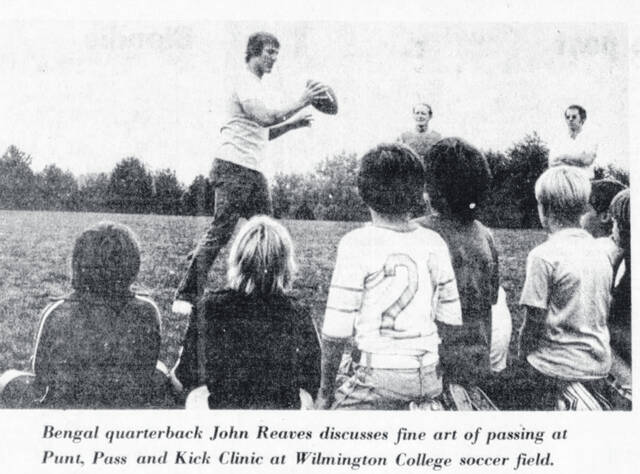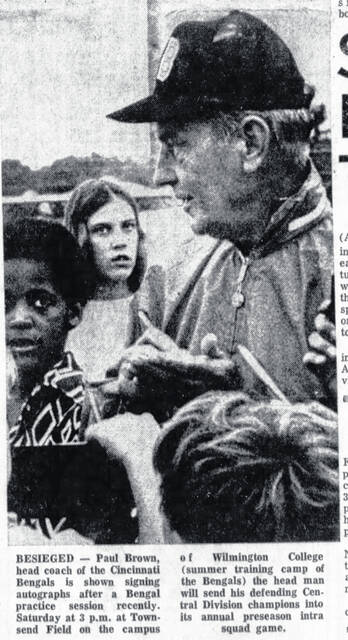


As the Cincinnati Bengals quickly approach the AFC Championship game on Sunday, many Clinton County fans are sure to be watching from their homes. But for many years Clinton Countians had a front row seat to the Bengals action – as spectators at Wilmington College!
What surprises me most when talking to people about our community’s history is the fact that Clinton County is home to some highly accomplished and well-known individuals, including even Coach Paul Brown himself during the summer months of the late 1960s to the ’90s.
The Cincinnati Bengals called Wilmington College home during their summer training camps for almost 30 years. The team practiced at WC’s Townsend Field from 1969 to 1996 for approximately 4-8 weeks annually.
The players typically immersed themselves into the community, visiting the local fair, dining at restaurants in town, and enjoying the rural culture Clinton County provided them. All players took up residency in the Wilmington College dorms while they practiced.
Most dorms were not equipped with the amenities of today and some veteran players were smart enough to furnish their own AC units, while the rookies suffered the long summer heat.
There are currently two stories about what led Brown to Clinton County.
According to a 2017 article by former local sports reporter Michael Graham, Paul Brown noted in his autobiography that “he wanted to see Hermann Court, the new fieldhouse adjacent to the football stadium, but its doors were locked. He and Mike were about to leave town when the unidentified custodian, a woman, let them inside the building and gave them a guided tour of its impressive accommodations.”
A Wilmington News Journal article from August 1968 discusses how the “Who Dey” supposedly found their way to the small town of Wilmington. It states Kenny Camp was employed in the maintenance section of the college when an older man approached him to inquire about the facilities at W.C.
Kenny was not a public relations employee but he kindly explained to the stranger “everything he wanted to know about the plant, the equipment and the operation.” The man left pleased with what he heard and had experienced during his visit to Wilmington.
Unbeknownst to Kenny, that gentleman was Mr. Paul Brown, 59 years old and the head coach and owner of the Cincinnati Bengals.
Either way, Brown was visiting Clinton County in search of a summer home for his players and a place where he could put “together plans for a comeback” after coaching the Cleveland Browns. He left content that he found his next training site.
As a result of the Bengals laying claim to Wilmington, the community witnessed a significant uptick in visitors, publicity, and overall town pride. An exciting summer of sports activity in a small farming community of Southern Ohio.
But some were opposed to the Bengals’ training camp being housed in Wilmington and had concerns about potential traffic jams and the fear that players may misbehave in the community.
A local article from 1971 stated “upwards of 2,000 spectators” were drawn to Townsend Field daily to watch the Bengals practice. Spectating at the college’s field was free to all, but a 50-cent service fee was noted for those using off-street parking in the campus lots.
The Cincinnati Jaycees club even shuttled upwards of 1,500 fans on chartered buses to watch the practices in Wilmington.
In 1968 a local tea was planned for the wives of players who had been selected for the final season roster. Some 2,500 “welcome Bengals” bumper stickers were distributed to local merchants downtown to sell and a Wilmington, Clinton County Day was held by Brown in 1975 to allow fans an up-close and personal encounter with their favorite football team.
The event also helped to promote Wilmington College’s offerings and facilities at the same time.
It would be a shame not to recognize how the “Orange and Black” slowly encompassed the local community. Over the course of those summer practices, three hometown grads tried out for the team including Mike Wilson, who played two seasons with the Bengals; Gary Williams, who was a Bengal for one season; and Billy Ray Anders.
According to Michael Graham, the local after-hours hangout for the “Who Dey” group “was the Driftwood Lounge, a cool, dark room in the local bowling alley on the outskirts of town.”
Food service manager at the time, Phil Clark, commented on just how much the Bengals team typically ate while practicing locally. A typical day started with a hearty breakfast, then led to a lunch break near noon full of sandwiches and sides. The team finished their day with a team meal of meats, vegetables, and a salad buffet.
Clark stated they “would eat 20-30 pounds of tomatoes each day.” Documents note approximately 23 summer students worked a total of 200 hours in the kitchen each week cooking for the team in 1970.
Overall, the history of Bengals Training Camp in the small community of Clinton County ought to put some hometown pride in fans rooting for the team this weekend.
It is important to realize, local history can often play vital roles in larger aspects of our lives today – take this event or many others, for example.
History is not that boring, stuffy information in textbooks; it’s living, breathing examples of our community’s past connections.
Remember as you are cheering “Who Dey!” from the sofa this Sunday, that your parents or even grandparents were probably cheering them on from the sidelines of Wilmington’s own Townsend Field.
(Author’s Note: A special thank you to Michael Graham, Phil Snow, Dana Dunn, and others who contributed to my research efforts of this piece).




